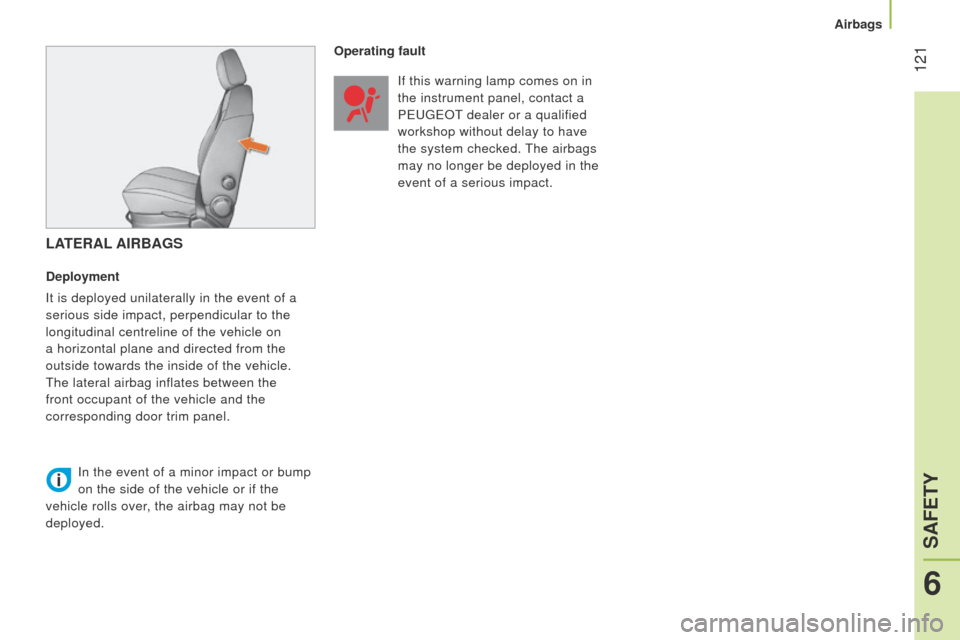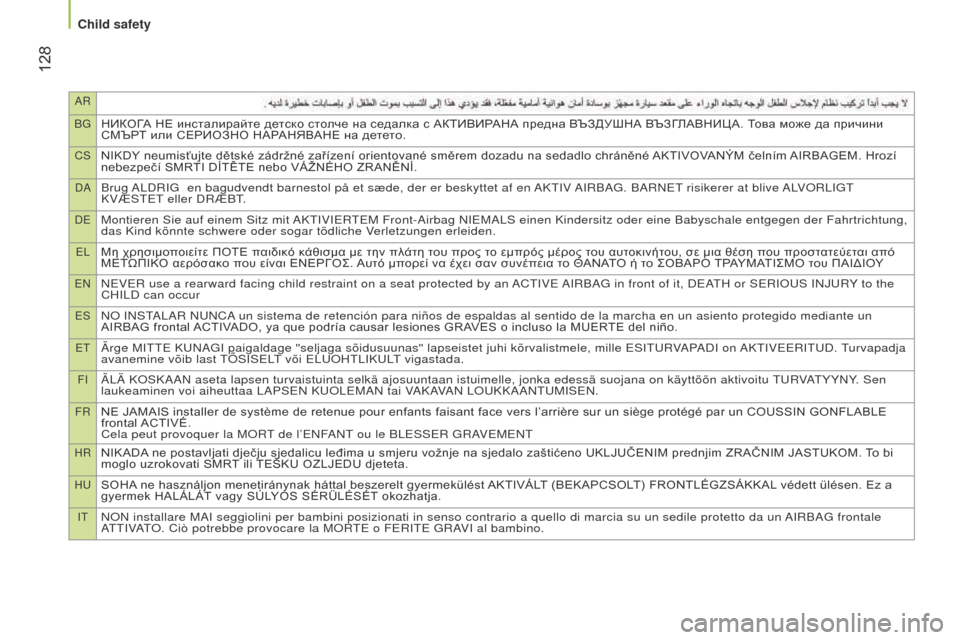2015 Peugeot Bipper ESP
[x] Cancel search: ESPPage 99 of 192

97
Bipper_en_Chap05_technologie_ed02-2014
When prompted by the telephone, enter the
PIN displayed in the instrument panel.
If the pairing has been successful, the
system announces "Connecting".
t
he name of the telephone identified
appears in the instrument panel screen,
pairing is confirmed.
"Settings"\wait for a
response\"Pairing".
PIN
Pairing a mobile telephone
Pairing consists of setting your vehicle's
Bluetooth
® system to recognise your mobile
telephone.
For this you must activate the Bluetooth
®
function of your telephone and set its
visibility.
MOBILE TELEPHONE WITH HANDS-FREE FUNCTION
With the ignition on, activate the
main menu.
Select S
ett IN g S.
Confirm.
Select PAIRIN
g .
Confirm.
t
his number, which permits
recognition of your mobile
telephone, is generated
randomly by the system.
It is communicated by the instrument panel
screen and is repeated verbally by the
system.
t
his PIN is independent of your SIM card
and your mobile's access code.
Once your handset has been paired, there is
no need to keep a record of this number.
If you change your mobile telephone, you
must repeat the pairing procedure as you
will be given a new PIN.
l
ook for the option which displays
the Bluetooth
® system detected
by your telephone.
When the system has been
identified, a message appears in
your telephone (My car,
…).
Pressing MAIN or eSC during the pairing
phase may cancel the procedure.
If the pairing fails, an error message will
appear; in this case, repeat the procedure.
teCHNOlOgY on BOARD
Bluetooth hands-free system
5
Page 118 of 192

11 6
Bipper_en_Chap06_securite_ed02-2014
TYRE UNDER-INFLATION DETECTION
System which automatically checks the
pressure of the tyres while driving.
t
he system monitors the pressures on the
four tyres, once the vehicle is moving.
It compares the information given by the
four wheel speed sensors with reference
values, which must be reinitialised every
time the tyre pressures are adjusted or a
wheel changed.
t
he system triggers an alert as soon as it
detects a drop in the inflation pressure of
one or more tyres.
t
he under-inflation detection system
does not replace the vigilance or the
responsibility of the driver.
t
his system does not avoid the need to
check the tyre pressures (including the
spare wheel) every month as well as before
a long journey.
Driving with under-inflated tyres impairs
road holding, extends braking distances and
causes premature tyre wear, particularly
under arduous condition (high loading, high
speed, long journey).
Driving with under-inflated tyres increases
fuel consumption.
t
he inflation pressures defined for
your vehicle can be found on the tyre
pressure label.
See the "Identification markings" section.
tyre pressures should be checked when the
tyres are "cold" (vehicle stopped for 1 hour
or after a journey of less than 6 miles
(10 km) at moderate speeds).
Otherwise (when hot), add 0.3 bar to the
pressures shown on the label.
Under-inflation alert
This is given by fixed
illumination of this warning lamp,
accompanied the display of a
message,depending on equipment.
F
Reduce speed immediately
, avoid
excessive steering movements and
sudden braking
F
Stop the vehicle as soon as it is safe to
do so.
t
he loss of pressure detected does
not always cause visible bulging of the
tyre. Do not satisfy yourself with just a visual
check.
F
In the event of a puncture, use the
temporary puncture repair kit or the spare
wheel (depending on equipment),
or
F
if you have a compressor
, such as the
one in the temporary puncture repair kit,
check the pressures of the four tyres
when cold,
or
F
if it is not possible to make this check
immediately, drive carefully at reduced
speed.
t
he alert is maintained until the system
is reinitialised.
Driving safely
Page 123 of 192

121
Bipper_en_Chap06_securite_ed02-2014
LATERAL AIRBAGS
Deployment
It is deployed unilaterally in the event of a
serious side impact, perpendicular to the
longitudinal centreline of the vehicle on
a horizontal plane and directed from the
outside towards the inside of the vehicle.
t
he lateral airbag inflates between the
front occupant of the vehicle and the
corresponding door trim panel.
In the event of a minor impact or bump
on the side of the vehicle or if the
vehicle rolls over, the airbag may not be
deployed. Operating fault
If this warning lamp comes on in
the instrument panel, contact a
P euge O t
dealer or a qualified
workshop without delay to have
the system checked.
t
he airbags
may no longer be deployed in the
event of a serious impact.
6
SAFETY
Airbags
Page 130 of 192

AR
B g
НИКОГА НЕ инсталирайте детско столче на седалка с АКТИВИРАНА предна ВЪЗДУШНА ВЪЗГЛАВНИЦА. Това може да причини
СМЪРТ или СЕРИОЗНО НАРАНЯВАНЕ на детето.
CSNIKDY neumisťujte dětské zádržné zařízení orientované směrem dozadu na sedadlo chráněné AKTIVOVANÝM čelním AIRBAGEM. Hrozí
nebezpečí SMRTI DÍTĚTE nebo VÁŽNÉHO ZRANĚNÍ.
DABrug AlDRIg en bagudvendt barnestol på et sæde, der er beskyttet af en AKtIV AIRBAg. BARNet risikerer at blive A lVOR l I gt
KVÆS tet eller DRÆB t.
DeMontieren Sie auf einem Sitz mit AKtIVIeRte M Front-Airbag NI e MA l S einen Kindersitz oder eine Babyschale entgegen der Fahrtrichtung,
das Kind könnte schwere oder sogar tödliche Verletzungen erleiden.
elΜη χρησιμοποιείτε ΠΟΤΕ παιδικό κάθισμα με την πλάτη του προς το εμπρός μέρος του αυτοκινήτου, σε μια θέση που προστατεύεται από
ΜΕΤΩΠΙΚΟ αερόσακο που είναι ΕΝΕΡΓΟΣ. Αυτό μπορεί να έχει σαν συνέπεια το ΘΑΝΑΤΟ ή το ΣΟΒΑΡΟ ΤΡΑΥΜΑΤΙΣΜΟ του ΠΑΙΔΙΟΥ
eNNeVeR use a rearward facing child restraint on a seat protected by an ACtIVe AIRBAg in front of it, DeAt H or S e RIO u S INJ u RY to the
CHI l D can occur
eSNO INStA l AR N u NCA un sistema de retención para niños de espaldas al sentido de la m\
archa en un asiento protegido mediante un
AIRBAG frontal ACTIVADO, ya que podría causar lesiones GRAVES o incluso la MUERTE del niño.
etÄrge MItte KuNAgI paigaldage "seljaga sõidusuunas" lapseistet juhi kõrvalistmele, \
mille eSItuRVAPADI on AKtIVeeRItuD. turvapadja
avanemine võib last t ÕSIS elt või elu OH tl IK ult vigastada.
FIÄlÄ KOSKAAN aseta lapsen turvaistuinta selkä ajosuuntaan istuimelle,\
jonka edessä suojana on käyttöön aktivoitu tu RVAt YYNY. Sen
laukeaminen voi aiheuttaa l APS e N K u O le MAN tai VAKAVAN l O u KKAAN tu MIS e N.
FRNE JAMAIS installer de système de retenue pour enfants faisant face vers l’arrière sur un siège protégé par un COUSSIN GONFLABLE
frontal ACTIVÉ.
Cela peut provoquer la MOR
t de l’
e NFAN t
ou le B
le SS e R g RAV e M e N t
HRNIKADA ne postavljati dječju sjedalicu leđima u smjeru vožnje na sjedalo zaštićeno UKLJUČENIM prednjim ZRAČNIM JASTUKOM. To bi
moglo uzrokovati SMRT ili TEŠKU OZLJEDU djeteta.
HuSOHA ne használjon menetiránynak háttal beszerelt gyermekülést AKTIVÁLT (BEKAPCSOLT) FRONTLÉGZSÁKKAL védett ülésen. Ez a
gyermek HALÁLÁT vagy SÚLYOS SÉRÜLÉSÉT okozhatja.
ItNON installare MAI seggiolini per bambini posizionati in senso contrario\
a quello di marcia su un sedile protetto da un AIRBAg frontale
Att IVAtO. Ciò potrebbe provocare la MORte o F e RI te g RAVI al bambino.
128
Bipper_en_Chap06_securite_ed02-2014
Child safety
Page 152 of 192

150
Bipper_en_Chap08_verifications_ed02-2014
Manual gearbox
the gearbox does not require any
maintenance (no oil change).
Refer to the warranty and maintenance
record for the checking interval for this
component.
Good practice
to check the main levels and certain
components, in accordance with the
manufacturer's servicing schedule, refer to
the pages of the warranty and maintenance
record which correspond to your vehicle's
engine.
Electronic gearbox
the gearbox does not require any
maintenance (no oil change).
Refer to the warranty and maintenance
record for details of the checking interval
for this component.
Only use products recommended by
P
euge O t
or products of equivalent
quality and specification.
In order to optimise the operation of units as
important as the braking system, P
euge O t
selects and of
fers specific products.
In order to avoid damaging the electrical
units, high pressure washing to clean the
engine compartment is strictly prohibited.
After washing the vehicle dampness, or in
winter, ice may form on the brake discs and
pads: braking efficiency may be reduced.
Make some light brake applications to dry
and de-ice the brakes.
Checks
Page 169 of 192

167
Bipper_en_Chap09_aide-rapide_ed02-2014
CHANGING A FUSE
the two fuseboxes are placed on the
dashboard on the driver ’s side and under
the bonnet.
Removing and fitting a fuse
Before changing a fuse, the cause of the
fault must be found and rectified.
t
he fuse
numbers are indicated on the fusebox.
Always use the special tweezer to extract
the fuse from its housing and check the
condition of its filament.
Always replace a faulty fuse with a fuse
of the same rating.
If a fuse fails again soon after replacement,
have the electrical system of your vehicle
checked by a P
euge O t
dealer or a
qualified workshop. Access to fuses in the dashboard
-
t
o gain access to the dashboard fuses,
remove the 2 screws using the ignition
key and tilt the housing.
P
euge
O
t
will not accept responsibility
for the cost incurred in repairing your
vehicle or for rectifying the malfunctions
resulting from the installation of accessories
not supplied and not recommended by
P
euge
O
t
dealers and not installed in
accordance with its instructions, in particular
when the combined consumption of all of
the additional equipment connected exceeds
10
milliamperes.
A.
Good.
B.
Failed.
C.
T
weezer.
Access to fuses in the engine
compartment
-
For access to the fuses in the engine
compartment, remove the left hand front
headlamp connector, then unclip the
fusebox cover.
9
QUICK HELP
Changing a fuse
Page 182 of 192

180
Bipper_en_Chap10_caracteristique_ed02-2014
DIESEL ENGINES1.4 litre HDi 70 hp1.3 litre HDi 75 hp
Gearboxes ManualManualElectronic
g
ears 555
eu
standard maximum power (kW)* 5055
Cubic capacity (cc) 1 3991 248
Bore x stroke (mm) 73.7 x 8269.6 x 82
Max power engine speed (rpm) 4 0003 750
eu
standard max torque (Nm) 160190
Max torque engine speed (rpm) 2 7501 750
Fuel DieselDiesel
Catalytic converter Ye sYe s
Particle emissions filter (PEF) NoYe s
Stop & Start NoYe s
Engine oil capacity with filter replacement (litres) 3.83.0
*
The maximum power corresponds to the value type-approved on a t
est bed, under conditions defined in European legislation (Directive 1999/99/EC).
Engines
Page 183 of 192

181
Bipper_en_Chap10_caracteristique_ed02-2014
PETROL ENGINE1.4 litre 75 hp
Gearbox Manual
g
ears 5
eu
standard maximum power (kW)* 54
Cubic capacity (cc) 1 360
Bore x stroke (mm) 75 x 77
Max power engine speed (rpm) 5 200
eu
standard max torque (Nm) 11 8
Max torque engine speed (rpm) 2 600
Fuel
u
nleaded petrol
Stop & Start No
Engine oil capacity with filter replacement (litres) 3.0
*
The maximum power corresponds to the value type-approved on a t
est bed, under conditions defined in European legislation (Directive 1999/99/EC).
Engines
TECHNICAL DATA
10